Oil flows through the Bab el-Mandeb Strait, a key chokepoint at the Red Sea’s southern entrance, have fallen by over 50 per cent in 2024, averaging 4.0 million barrels per day (bpd) compared to 8.7 million bpd in 2023.
According to the US Energy Information Administration (EIA), the sharp decline follows intensified Houthi attacks on vessels in the area, prompting many tankers to reroute around Africa’s Cape of Good Hope. Consequently, oil flow via the Cape surged to 9.2 million bpd from 6.0 million bpd last year, Vortexa reports.
The Bab el-Mandeb, Suez Canal, and the Strait of Hormuz remain vital for global oil supply. The Hormuz Strait alone carried 20.9 million bpd in 2023—about 20 per cent of global petroleum consumption—underscoring its significance to global energy security.
Meanwhile, Saudi Arabia remains the top global oil exporter at 9.5 million bpd, while Iran has increased production to 4.0 million bpd despite sanctions. As of October 10, Middle Eastern tensions, including recent Israel and Iran altercations, have pushed Brent crude prices to $79 per barrel, highlighting the region’s impact on global oil prices.
Attribution: EIA
Subediting: Y.Yasser



